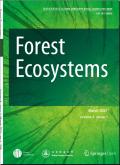Leaf morphological trait integration and modularity provide insights into ecological adaptation in evergreen oaks
IF 4.4
1区 农林科学
Q1 FORESTRY
引用次数: 0
Abstract
The integration and modularity of leaf morphological traits are fundamental to plant adaptations, yet their responses to diverse environmental pressures remain unclear. In this study, we investigate the roles of leaf trait integration and modularity and how they interact with environmental factors. We analyzed geometric, traditional, and functional leaf traits across 908 individuals from 72 populations of two alpine evergreen oaks, Quercus aquifolioides Rehder & E.H. Wilson and Quercus spinosa David ex Franch., distributed throughout the Himalayan-Hengduan Mountains (HHM), employing genetic assignment as a priori. Multivariate and redundancy analyses revealed that Q. aquifolioides, which inhabits harsher environments, exhibits lower trait integration and greater morphological flexibility, allowing for dynamic adaptation to fluctuating conditions. In contrast, Q. spinosa, thriving in milder environments, demonstrates stronger integration and stability in leaf morphology, facilitating resource optimization and providing a competitive advantage. Notable differences in modularity between the two species were observed, particularly in specific leaf traits, as revealed by structural equation modeling (SEM) analysis. These results underscore the adaptive significance of leaf trait integration and modularity in extreme environments and highlight the critical role of leaf morphology in enhancing species resilience.
叶片形态特征的整合和模块化为常绿栎树的生态适应性研究提供了新的思路
叶片形态特征的整合和模块化是植物适应的基础,但它们对不同环境压力的反应尚不清楚。在本研究中,我们探讨了叶片性状整合和模块化的作用及其与环境因子的相互作用。我们分析了两种高山常绿栎树(Quercus aquifolioides Rehder &) 72个种群908个个体的几何、传统和功能叶片性状。e·h·威尔逊和栎木,大卫·弗兰奇。,分布于喜马拉雅-横断山脉(HHM),采用先验遗传分配。多变量分析和冗余分析表明,生活在更恶劣环境中的水杨花表现出更低的性状整合和更大的形态灵活性,从而能够动态适应波动的环境。相比之下,在更温和的环境中生长的刺蒺藜叶片形态具有更强的整合性和稳定性,有利于资源优化和竞争优势。结构方程模型(SEM)分析显示,两种植物的模块性存在显著差异,特别是在特定的叶片性状上。这些结果强调了叶片性状整合和模块化在极端环境下的适应意义,并强调了叶片形态在增强物种恢复力方面的关键作用。
本文章由计算机程序翻译,如有差异,请以英文原文为准。
求助全文
约1分钟内获得全文
求助全文
来源期刊

Forest Ecosystems
Environmental Science-Nature and Landscape Conservation
CiteScore
7.10
自引率
4.90%
发文量
1115
审稿时长
22 days
期刊介绍:
Forest Ecosystems is an open access, peer-reviewed journal publishing scientific communications from any discipline that can provide interesting contributions about the structure and dynamics of "natural" and "domesticated" forest ecosystems, and their services to people. The journal welcomes innovative science as well as application oriented work that will enhance understanding of woody plant communities. Very specific studies are welcome if they are part of a thematic series that provides some holistic perspective that is of general interest.
 求助内容:
求助内容: 应助结果提醒方式:
应助结果提醒方式:


